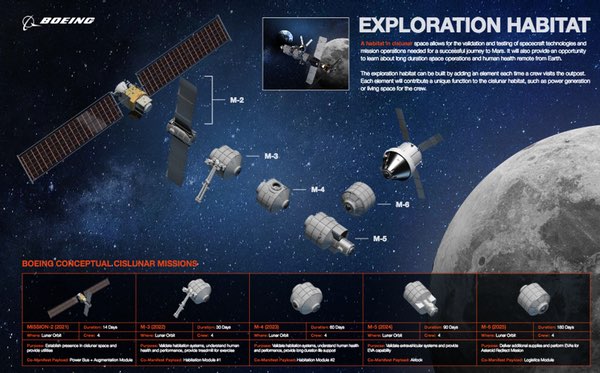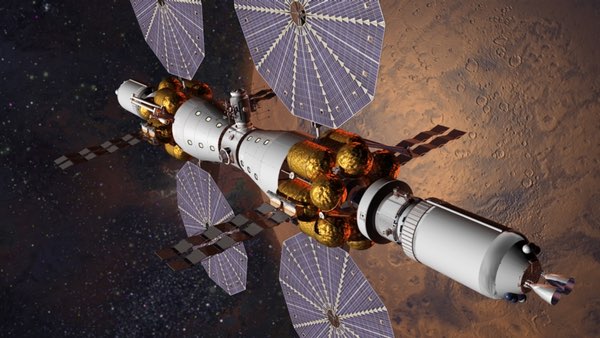Different paths to Marsby Jeff Foust
|
| “Mars is a long ways away. I think the next phase is going to be going to the area around the Moon—cislunar—and assemble an outpost there,” said Elbon. |
Both advocates and skeptics of Mars exploration, and of Musk and SpaceX, have anticipated this talk for months. Musk is expected to lay out the technical details of his plan to start sending humans to Mars, perhaps within a decade, an approach that is thought to involve a new heavy-lift launch vehicle and a spacecraft called the Mars Colonial Transporter (although apparently recent renamed the Interplanetary Transport System, after Musk noted on Twitter earlier this month the vehicle “can go well beyond Mars.”) Exactly what approach Musk will roll out, including details like schedules and costs, remain to be seen.
Musk, though, isn’t the only one talking about sending people to Mars recently. In the last several weeks, a number of companies and individuals, from industry technical conferences to advocacy meetings to the halls of Congress, have been talking about when and how to send people to Mars. They have the same destination in mind, but different approaches to get there.
Take, for example, Boeing. At the opening plenary session of AIAA Space 2016 conference in Long Beach, California, earlier this month, the company left on every seat a packet labeled “A Path to Mars.” In it was a collection of documents describing its building-block approach to human Mars exploration, with a particular emphasis on developing a habitat in cislunar space to test hardware and train astronauts for long-duration cruises to Mars and back.
“Mars is a long ways away. I think the next phase is going to be going to the area around the Moon—cislunar—and assemble an outpost there that can be used to improve the systems and capability to study crew heath in that environment,” said John Elbon, vice president and general manager of space exploration at Boeing Defense, Space and Security, during a panel session later at the conference.
That cislunar habitat would be assembled by taking advantage of additional space available in the Block 1B version of the Space Launch System. These “co-manifested payloads” would ride underneath the Orion spacecraft that is the SLS’s primary payload, allowing the components to be built up without the need of dedicated launches. Over the course of five years, at one SLS launch a year, the habitation modules, power system, and other elements of a cislunar habitat could be built up, allowing for missions up to 180 days by the mid-2020s.
That habitat, Boeing argues, would allow NASA to develop experience beyond Earth orbit needed before multi-year missions to Mars. “With the Mars mission being the long duration that it is, and the challenges that it presents, we don’t want to just take that step and send a crew immediately to Mars,” said Darby Cooper, a launch vehicle architect at Boeing, during a panel on Capitol Hill last week organized by Explore Mars.
Cooper said that while work on the International Space Station does provide experience, it’s like camping in your backyard: easy to run inside if something goes wrong. “The lunar environment is like a nice, friendly state park down the road,” he said, one that is still fairly easy to get to, but more remote than that backyard.
 A Boeing illustration of the missions it proposes to fly in the early to mid 2020sto establish a cislunar habitat as the next major step towards Mars. (credit: Boeing) |
Orbital ATK, meanwhile, is studying a similar approach, making use of modified versions of its Cygnus cargo spacecraft to serve as the basis for a cislunar habitat. “Our concept just leverages that Cygnus module. We grow it a little bit, we add capabilities to it,” said Kent Rominger, vice president of strategy and business development at Orbital ATK’s propulsion systems division, at the Explore Mars event.
| “We think that, by 2025, we can do a one-year shakedown cruise,” Cichan said. “If we’re going to make it to Mars by 2028 we need to be moving quickly.” |
Lockheed Martin is taking a slightly different approach. It, too, is looking to establish a cislunar habitat as a stepping-stone to Mars. But its “Mars Base Camp” proposal, announced earlier this year, goes one step further: it would use cislunar space to assemble and test a Mars spacecraft that could perform a Mars orbital mission, including sorties to the moons Phobos and Deimos, as soon as 2028.
The spacecraft envisioned by Lockheed Martin is symmetric, with identical-looking habitat and laboratory modules on opposite sides of a central node, with Orions docked at each end. “It’s very symmetric, and that’s by design,” said Timothy Cichan, space exploration architect at Lockheed Martin Space systems, in a speech last week at the 19th Annual International Mars Society Convention in Washington. Redundancy within individual components alone is not enough, he said. “There is always a redundant aspect of the spacecraft for the crew to retreat to, figure out what they’re going to do, and go and repair the damage.”
A 2028 mission would require an aggressive schedule of missions involving not only the SLS but also launches by international or commercial partners, setting up infrastructure for the transit spacecraft in cislunar space while also pre-positioning other hardware in Mars orbit. Some of the components he described, like the large “tank farms” on either end of the spacecraft, require the use of the more powerful Block 2 version of the SLS, whose development may be years in the future.
“We think that, by 2025, we can do a one-year shakedown cruise,” Cichan said. “That’s an acceleration of flight test objectives, but if we’re going to make it to Mars by 2028 we need to be moving quickly.”
Cichan said that, at this early stage of development, there’s no firm cost estimate for the Mars Base Camp mission. “It’s designed to fit into the human exploration budgets that we see moving forward,” he said, including the assumption that NASA ends ISS operations in 2024.
While the details differ, all three take similar approaches to using cislunar space to establish habitats for building up experience before mounting human missions to Mars. All three companies also have NASA Next Space Technologies for Exploration Partnerships (NextSTEP) contracts to study those cislunar designs, supporting the “proving ground” vision NASA has for its overarching Journey to Mars concept.
“Hopefully, what you all see today is a lot of similarity,” said Rominger at the Explore Mars event, which also included presentations by Boeing and Lockheed Martin for an audience of both space professionals and advocates as well as congressional staffers. “The primes that are supporting NASA’s Journey to Mars today have different concepts, but hopefully you’ll appreciate how similar they are all.”
The comments about not going directly to Mars may be subtle criticisms of SpaceX’s apparent vision of going to Mars as soon as possible, without building much, if any, infrastructure in cislunar space. Boeing, in its “A Path for Mars” documents, also emphasized both the importance of experience in going to Mars (“when the safety of brave men and women is at stake, there can be no substitute” for experience, it states) and that Boeing has extensive experience in human spaceflight.
But the direct-to-Mars approach still has supporters. At the Mars Society conference, founder and president Robert Zubrin, who first proposed his Mars Direct concept more than a quarter-century ago, continued to pitch versions of it as the best, fastest way to get humans to Mars. “This does not have to be a task for the next generation,” he said, “although the next generation from 1990 has now arrived.”
| “I don’t know if this [Mars Semi-Direct] is the plan,” Zubrin said of Musk’s speech. “I’m sure it will be different than this.” |
Zubrin, in his opening comments at the conference, discussed a “Mars Semi-Direct” approach that would make use of SpaceX’s Falcon Heavy launch vehicle to allow two-person Mars missions with a minimum of new vehicle development. “It’s going to be an easier sell, and it’s going to get progressively easier to sell as more and more of these hardware elements are developed,” he said, calling the concept an “existence proof” of low-cost Mars missions.
What Elon Musk will unveil Tuesday in Guadalajara is likely to be different from both the cislunar concepts being discussed by industry, or even Zubrin’s Mars Semi-Direct concept. “I don’t know if this [Mars Semi-Direct] is the plan,” Zubrin said of Musk’s speech. “I’m sure it will be different than this.”
But as various companies and individuals discuss their plans for going to Mars, it’s worth remembering that answering the question of how to go to Mars is dependent on not just the available technologies and budgets—important as they may be—but also on the answer to the question of why to go to Mars. And Musk, with his vision of permanent human settlements on Mars that his architecture will presumably enable, may set himself apart from other companies on the “why” question far more than any choice of launch vehicle or spacecraft ever would.
